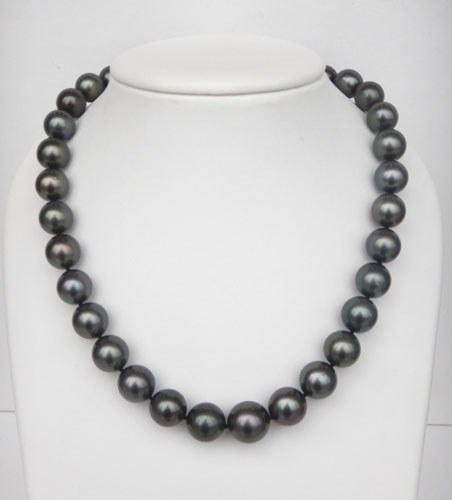Tahitian Pearls
Posted on Wednesday, August 29th, 2018
in Pearls.
Known for their dark overtones, Tahitian pearls first came into the limelight during the 1970’s when they quickly became a symbol of status and prestige. Here’s everything you need to know about these gorgeous gems.
- The history of Tahitian pearls starts in 1973, when Salvador Assael partnered with Jean Claude Brouillet and launched their Tahitian pearl culturing operation. Many jewelers were initially skeptical of these pearls since they believed their color came from artificial dye. However, after sending a strand of Tahitian pearls to the GIA, it was confirmed that these pearls did in fact naturally display dark colors. The industry really took notice then, and soon some of the finest jewelry houses in the world were carrying Tahitian pearl jewelry. Almost overnight, Tahitian pearls were considered the most valuable of all cultured pearls.
- The popularity for these pearls led to a Tahitian “pearl rush” during the 1980’s. By 1985, 600,000 pearls were being harvested annually, and fine strands could sell for a million dollars. To take advantage of the gem’s popularity and expand the Tahitian pearl industry, the French Polynesian government began issuing pearling permits and licenses to nearly anyone who wanted one. This ended up being disastrous as overproduction and poor farming techniques led to low quality Tahitian pearl harvests. To prevent these low quality pearls from marring the international image of Tahitian pearls, the government instituted an export tax and created a grading system that ensured only the best quality pearls would be exported.
- Even though they are sometimes referred to as “black pearls,” Tahitian pearls are rarely ever black. They can actually occur in a variety of different colors. The finest pearls exhibit dark green and blue colors, with iridescent overtones of rose and gold. A Tahitian pearl’s color is one of its most important value factors, with the darker and more intensely colored pearls commanding the highest value.
- Tahitian pearls grow in black-lipped mollusks called Pinctada margaritifera.
- These pearls tend to grow in size anywhere from eight to thirteen millimeters. Their large size can be attributed to the mollusk’s lifespan and size. These mollusks can live up to 30 years in the wild and can grow to a length of about one foot. Smaller pearls in the six and seven millimeter range can be found as well, but are rare, as are pearls larger than sixteen millimeters.
- Robert Wan is known as “the Mikimoto of Tahiti.” He played a vital role in the early stages of the Tahitian pearl industry and eventually produced 50 percent of the pearls grown in French Polynesia.
- Even though many people associate black pearls with Tahiti, these darkly colored pearls are not limited only to the South Pacific. Other locations, like Mexico’s Sea of Cortez, are known to produce black pearls as well. It’s important to note, however, that only pearls grown in French Polynesia can be called Tahitian.
- Five groups of islands make up French Polynesia, but almost all pearl farms are found in the largest and smallest groups—the Tuamotu Archipelago and the Gambier Islands. Some of the very first pearls were produced on Bora Bora, but pearls are no longer farmed there. The preferred locations for pearl farms are the many atolls (rings of rock and coral remnants of sunken volcanoes from a long time ago) that make up the islands of French Polynesia. These atolls offer some protection from the damaging weather that occurs in the South Pacific Ocean.
- Unlike most other cultured pearls, the nacre of a Tahitian pearl is opaque. Light doesn’t penetrate the nacre and diffract the way it does in fine quality akoya pearls.
- Tahitian pearls are traditionally harvested between May and November. Of the shells harvested, only about forty percent will produce saleable pearls. Less than one percent of them will be gem quality.
Shop Kloiber Jewelers’ Tahitian pearl collection here and learn more about the three other main pearl types: freshwater, akoya, and South Sea.


